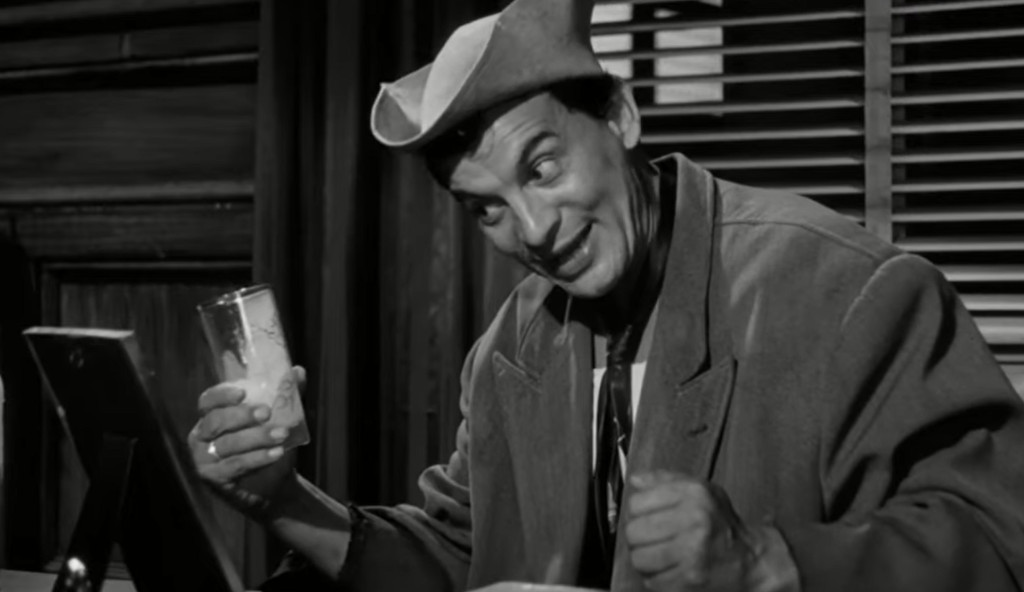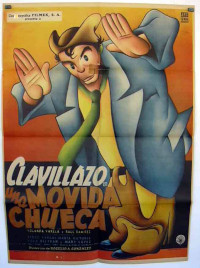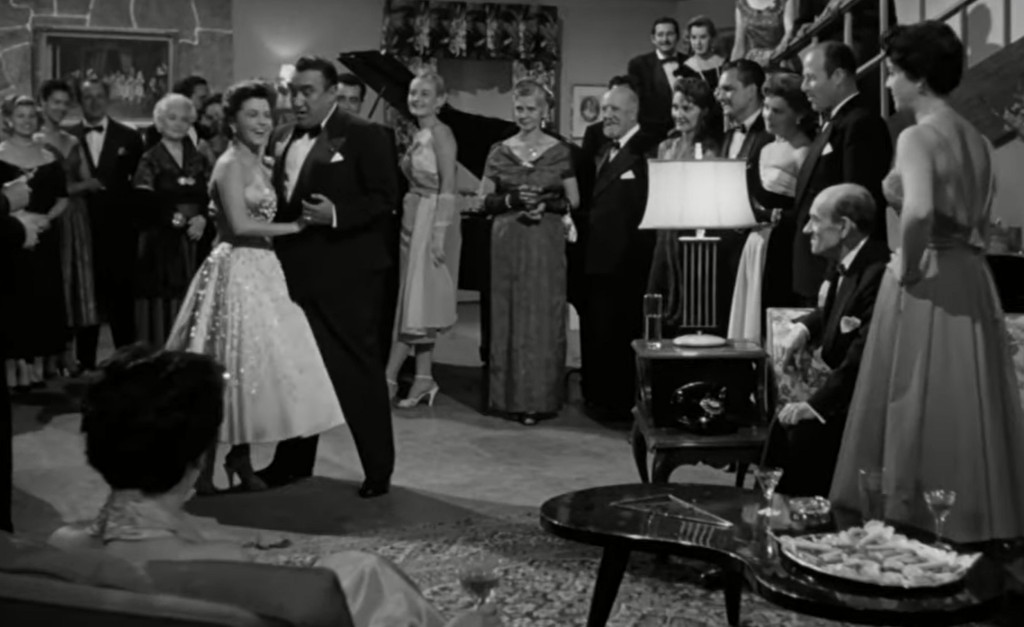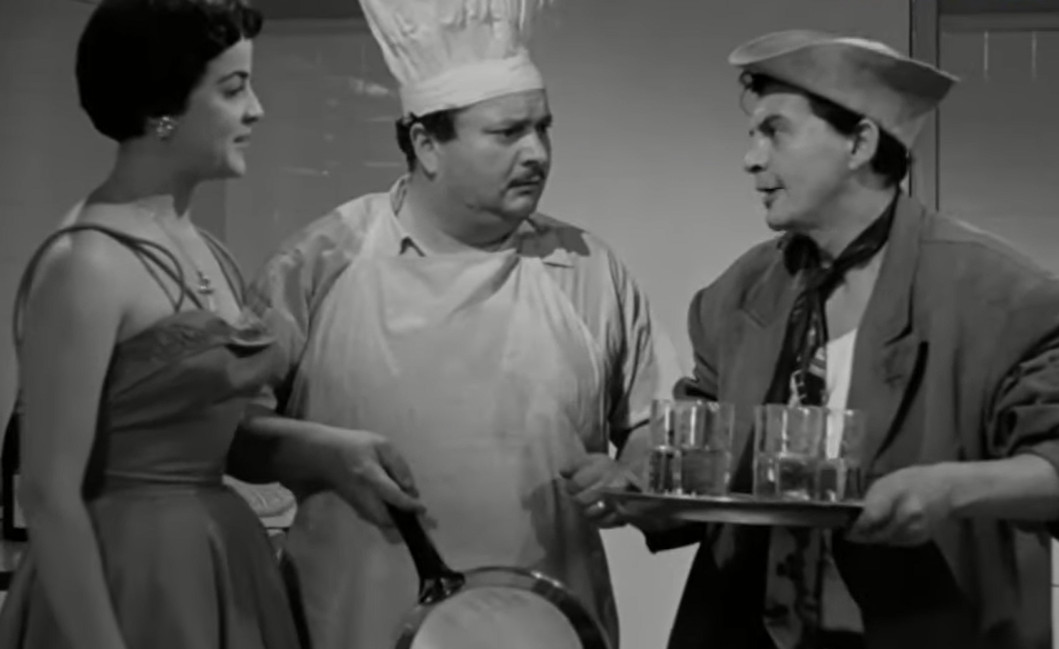
A well-meaning goofball is injected with a serum that allows him to see future events. Suddenly there is no end of people wanting to take advantage of the kind-hearted tramp. This Mexican 1956 effort is a minor film for comedian Clavillazo. 4/10
Una movida chueca. 1956, Mexico. Directed by Rogelio A. Gonzáles. Written by Fidel Ángel Espino,et.al. Starring: Antonio Espino (Clavillazo), Yolanda Varela, Raúl Ramirez, Dolores Camarillo, Óscar Ortiz de Pinedo, Luís Aragón, Arturo Soto Rangel, Pedro de Aguillon. Produced by Gregorio Walerstein. IMDb: 6.2/10. Rotten Tomatoes: N/A. Metacritic: N/A.

Although Mexico has never been one of the main exporters of science fiction movies, the country had up until 1956 produced a number of SF films on low intensity since the thirties, starting with Los muertos hablan in 1935 (review). I have reviewed two Mexican sci-fi comedies, the dreadful Buster Keaton vehicle Boom in the Moon (1946, review) and the much better The Genius (1948, review), starring Mexico’s biggest movie star, comedian Cantinflas. Yet another one came along in the early days of January 1956, this time with another comedy star, Clavillazo, in the lead; Una movida chueca.
The film doesn’t seem to have a designated English title, but “movida chueca” is used much in the same way as the English phrase “monkey business”, which is as good a title as any for the movie. It’s an imprecise, almost nonsensical title that has a sense of comedy about it. However, this is not to say that this film in any way resembles the 1952 Cary Grant/Marilyn Monroe vehicle Monkey Business (review). According to the phrase book Al buen entendedor (Marroquin, 1988), the phrase “es una movida chueca” was something of a catch phrase for Clavillazo, however, the one he is mainly remembered for is “pura vida!”
I haven’t been able to find a dubbed or subtitled version, and my Spanish could use improvement, so there are things in this movie that went over my head, as I had to rely on Youtube’s auto-translation. The first half of it is easy enough to follow, but I sort of lost track of things towards the end, because it’s almost completely made up of talking heads. Much of the comedy is also verbal, which means I probably didn’t enjoy the film as much as I would, had I been able to understand the jokes. As is usual in cases such as this, I give the film the benefit of a doubt, and award it an extra star for the stuff that I didn’t understand.

Set in then-contemporary Mexico, the film opens with a scientist (Arturo Soto Rangel) proclaiming that after years of work, he has perfected an injection that will give the test subject the ability to see the future in his dreams. To test it, he needs to find someone who is pure at heart, and will not use his new-found abilities for nefarious purposes, preferably someone of little importance. He sends his assistant out in the streets to find such a man. The assistant lays eyes on the tramp Clavillazo (real name Antonio Espino), a sweet-hearted jokester without a penny to his name, and offers him a reward for taking part in an experiment where all he has to do is sleep. Clavillazo agrees. He protests somewhat when he sees that he is going to be injected, but finally succumbs to some forceful persuasion.
Through a number of coincidences, he soon finds himself at the offices of a newspaper threatened by closure because of its reporters’ inability to find news in time for printing. There he is hired as a nightwatchman. At night he helps himself to the editor’s booze, and starts talking in his sleep. A reporter walks in on him, and hears him describing a huge fire (I can’t make out what building is supposed to burn down). When the building actually does burn down during the night, Clavillazo is arrested as a suspect and thrown into jail. He gets into further trouble because of his nightly predictions, but is soon set free and returns to the newspaper, where he again falls asleep during his shift. The reporter once again walks in on him as he talks in his sleep, but this time checks out the information Clavillazo is giving, and lo and behold! It actually happens, and the reporter gets credit for his excellent reporting the next day.

The second half of the film takes place at some sort of fancy party at a big mansion. There are three different musical numbers by some of Mexico’s biggest singing stars, some slapstick comedy and lots and lots of talking heads. Clavillazo falls asleep again, and is spied on by the reporter, the newspaper’s owner and editor. More talking heads, as I assume they discuss how to make millions on Clavillazo’s abilities. Complications ensue, and at some point he is back at the scientist’s lab, and presumably told what the experiment is about, because after this he starts trying to predict lottery numbers for people on the street. Apparently things don’t go as planned, because the mob returns, angry. Not quite sure what happens then, but in the end Clavillazo has a huge bundle of money, which he throws in the air for all the poor people to collect. There is also a subplot featuring Yolanda Varela, but she appears to be more of a friend who takes pity on Clavillazo than a romantic partner.

The script of the film was written by actors/writers Fidel Ángel Espino, Carlos Orellana, Manuel Tamés hijo and Pedro de Urdimalas, all seasoned screenwriters, none whom of have made any more lasting impression on the history of Mexican cinema. The story is easy enough to follow during the first half, even without subtitles, it moves along at a decent pace and there are some pretty funny sequences. Clavillazo/Espino does good physical comedy in the scene at the doctor’s, and there’s a nice brawl at the prison. However, things grind to a halt halfway through, when the story gets stuck with talking heads and endless musical performances at the party in the mansion. Pedro Vargas, María Victoria and Lola Beltrám are all very pleasant to listen to, but the numbers have no bearing at the plot whatsoever. The three just turn up to sing in the middle of the floor, as one perhaps would at a dinner party. The other actors listen, there’s not anything in the way of a show – no dancers, no costumes, no gags or ploys. Nothing else happens during the performances, and after they are over, the story just continues as normal. Pedro Vargas has a small speaking role in the film, but nothing that would require him singing. For fifteen minutes, the film is simply held up by singing.
As mentioned, I lost part of the story towards the end, but as far as I can tell, this is a very classic Mexican tale of the little guy from the street against the establishment of the rich. Clavillazo is the good-hearted tramp who is given a remarkable gift, and is immediately exploited by the rich and powerful for their own gain. In the end, justice is served, and Clavillazo shows how different he is by giving all his earnings to the needy.

The science fiction element is at least at the heart of the story, rather than just a MacGuffin, as in The Genius. But it is never well explained, other than being ”a serum”, and as such almost magical in nature. The plot, as far as I can tell, is fairly linear and straightforward. However the script is flawed inasmuch as I have described above, and seems to come to a halt halfway through. The low budget is obvious – almost all action takes place indoors in rather nondescript rooms and there are no effects to speak of. All the dramatic events that Clavillazo predicts happen off-screen and we are simply informed that they have taken place. The direction is competent but pedestrian, with mostly boring medium and wide shots, and director Rogelio A. Gonzáles’ framing is often flat and boring – a good part of the second act consists of two people sitting next to each other on a couch, talking. What small gags that exist, like Clavillazo falling down the stairs or throwing a pie, don’t do much to cheer up the dull stretch.
I suppose the latter half would work better if I understood the dialogue, but most Mexican reviewers (the few that I could find) seem to concur. On abandonmoviez.net, user Bigladiesman (very original) writes that the film is ”very simple, it is based essentially on the verbal gags and that close proximity to the ordinary citizen that usually characterise the Mexican comedies of the time”. He also writes that ”the technical aspects are no more than mediocre”, and that the film is ”enjoyable but forgettable”. Italian mymovies.it states that ”the film develops sluggishly and without surprises, merely exploiting the humor of the protagonist”. As stated, I haven’t been able to find a single proper article or review of Una movida chueca, and even in Mexican film lexica it appears as no more than a footnote to Clavillazo’s more famous films. Una movida chueca’s 6.2/10 IMDb rating is based, at the moment of writing, on only 23 audience votes. Despite this, the film isn’t hard to come by — it’s available on Youtube as a pretty decent quality TV rip.

If you understand Spanish or can find a subtitled version, I would recommend the film for a few laughs and as an example of the sort of science fiction comedy that became rather prevalent in the country in the latter part of the fifties and the sixties. It is a typical example of a film that could have been made at any time, set in any period, simply by exchanging the injected serum for, say, a magical medallion or a spell. The sci-fi here is only a very, very thin veneer, and Una movida chueca is really more of a classic fairy-tale in new clothes.
The character of Clavillazo is a staple of Mexican comedy – a poor man of the people, uneducated and blunt, a bit of a wise-cracker, a bit of a troublemaker, but ultimately a man with a kind heart and an unbreakable sense of justice and decency. The original mould for this character was naturally Charlie Chaplin’s tramp, but the Mexican blueprint was Cantinflas, born Mario Moreno. The character of Cantinflas, which Moreno used as an alter ego for the rest of his career, made his debut in 1939. Although adept at physical comedy, his puns were mainly verbal, and he set the template for a number of imitators. Although often in an employment of some sort, Cantiflas’ characters were were always lower or working class. Like Chaplin, he had dark, handsome features and melancholic puppy eyes, which sent women (and men, I’m sure) swooning.

Espino didn’t have Mario Moreno’s looks, and had to work for 20 years on perfecting a character that would make his name. Finally he happened on Clavillazo, which, like Cantinflas, is a fast-talker, but louder and broader. Clavillazo has a nervous, jerky, almost boisterous energy about him, often exaggerating his facial expressions and using a lot of hand gestures. So ubiqutous to his character was this last trait, that he became known as “the comedian with the talking hands”. According to the book Mexico’s Cinema (Hershfield, Maciel, 1999), Espino developed his peculiar “sign language” as a kid, when communicating with his deaf little brother. Whereas Cantinflas was recognised by his strange little moustache, the small red handkerchief around his neck and his array of hats, Clavillazo’s trademark was a pair of large Knickerbocker pants, a dinner jacket several sizes too big and a peculiar three-pointed hat. Although never challenging Cantinflas’ spot as Mexico’s comedian number one, Clavillazo was very popular throughout the fifties, and the early sixties, when Espino’s career started to decline somewhat. He kept on acting up until the mid-eighties, though. Clavillazo appeared in two more science fiction films; El castillo de los monstruos (1958) and Conquistador de la luna (1960).
Una movida chueca was directed by Rogelio A. Gonzáles, who is counted as one of the major directors and screenwriters of the golden age of Mexican cinema, often pinpointed to the period between 1935 and 1958. Interestingly enough, Mexican cinema at the time was fluid as far as roles on set went. Especially withing the comedic circles, people happily switched between acting, writing and directing. Gonzáles was nominated for a Silver Ariel (the Oscar of Mexico) four times, once for best supporting actor, once for best original screenplay, once for best adapted screenplay and once for best direction.

Gonzáles wrote and directed most genres, but it was his comedies that were his trademark. He made a number of films with the hugely popular actor and singer Pedro Infante, such as El gavilan pollero (1951), Ahora soy rico (1952), Un rincon cerca del cielo (1952) and School for Tramps (1955). Gonzáles helped build up Infante’s career to the point that he was one of the few stars in the country that that could match Cantinflas’ popularity. Infante is said to have considered Gonzáles his favourite screenwriter.
While never quite as influential as a Luis Buñuel, an Emilio Fernández or an Ismael Rodríguez, Gonzáles was nevertheless a very successful director, best remembered today for two of his later films, La culta dama (The Educated Lady, 1957) and El esqueleto de la señora Morales (Skeleton of Mrs. Morales, 1960). Especially the latter has garnered praise by later critics for its black, morbid humour and witty satire, and its been praised for its hitchcockian qualities. Friends of genre movies may take notice of Gonzáles because of his reasonably large contribution to Mexican science fiction movies; he made three more in his career: Conquistador de la luna, La nave de los monstruos (1960) and México 2000 (1983).

The supporting cast is on the whole decent. Starlet Yolanda Varela in the female lead gives proof of her acting chops, but her character is bland and inconsequential. Ariel-winner Arturo Soto Rangel appeared in a number of Hollywood films, including The Treaure of Sierra Madre (1948) and The Big Steal (1949). Ramón Valdés would become a TV star in the seventies in the popular sitcom El Chavo. A young María Victoria appears in a bit part – Victoria soon became one of the country’s most beloved comediennes, winning a Diosa de Plata life achievement award in 2006. Lola Beltrán is probably best known internationally for appearing on the soundtrack of No Country for Old Men (2007). Carlos Bravo y Fernández appeared in Hollywood productions such as Caboblanco (1981), Zorro: The Gay Blade (1981) and the John Carradine science fiction vehicle The Bees (1978). He also appeared in a number of Mexican sci-fis: Échenme al gato (1958), Santo vs. la hija de Frankestein (1972), Santo & Blue Demon vs. Doctor Frankenstein (1974), Visita al pasado (1981) and El superpolicia ochoochenta ‘880’ (1986).
Noted character actor Pedro de Aguillón also appeared in a number of sci-fi films: La sombra vengadora (1956, review), La sombra vengadora vs. La mano negra (1956), El superflaco (1959), The Hell of Frankenstein (1960), La marca del muerto (1961) and El futbolista fenómeno (1979). Luis Aragón appeared in Chano Urueta’s cult movie The Brainiac (1962) and Santo en el hotel de la muerte (1963). Óscar Ortiz de Pinedo acted in The Body Snatcher (1957), La casa del terror (1960), and Conquistador de la luna.

The soundtrack is decent, as far as I remember. Prolific composer Manuel Esperón won two Silver Ariels, one Salvador Toscano Medal and one lifetime achievement Special Golden Ariel. Editor Rafael Cabellos we have encountered before on Boom in the Moon. Production designer Jorge Fernández actually goes back all the way to Mexico’s first science fiction movie Los muertos hablan, and went on to design El baul macabro (1936), El enmascarado de plata (1954), Los platillos voladores (1956, review), La casa del terror (1960), and Kalimán en el siniestro mundo de Humanón (1976).
Janne Wass
Un movida chueca. 1956, Mexico. Directed by Rogelio A. Gonzáles. Written by Fidel Ángel Espino, Carlos Orellana, Manuel Tamés hijo, Pedro de Urdimalas. Starring: Antonio Espino (Clavillazo), Yolanda Varela, Raúl Ramirez, Dolores Camarillo, Óscar Ortiz de Pinedo, Luís Aragón, Arturo Soto Rangel, Pedro de Aguillon, Guillermo Portillo Acosta, Fidel Ángel Espino, Pepe Ruíz Vélez, Julio Monterde, El Verdugo, Ramón Valdés, Rafael Beltrán, Guillermina Rubi López, Carlos Bravo y Fernádez, Pedro Vargas, María Victoria, Lola Beltrán, Mary López. Music: Manuel Esperón. Cinematography: Augistin Martínez Solares. Editing: Rafael Ceballos. Production design: Jorge Fernández. Special effects: Armando Stahl. Produced by Gregorio Walerstein for Filmex.

Leave a comment